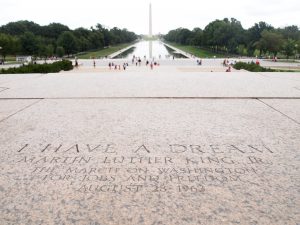 Want to teach kids about the MLK legacy in a way they can understand? These two Martin Luther King Jr. Day activities focus on key concepts with a simple, hands-on approach.
Want to teach kids about the MLK legacy in a way they can understand? These two Martin Luther King Jr. Day activities focus on key concepts with a simple, hands-on approach.
Celebrate Martin Luther King Jr. Day with Hands-on Activities
The Bus Boycott
One of the first events that established Martin Luther King, Jr., as a civil rights leader was the Montgomery Bus Boycott that started on December 5, 1955, and ended December 20, 1956. Sparked by Rosa Park’s refusal to give up her seat and her consequent arrest, the protest spread across Montgomery.
The Activity: Sit or Stand
The idea of this hands-on activity is to introduce the issue of the bus system in a more direct way before discussing the details. Ideally, then, students will be more interested and more involved when discussing the historic events.
Here’s how it works:
- Line up some chairs into two columns and about four rows. You can adjust the number based on the number of students you want to involve in each round. Just make sure that you have fewer chairs than you do students.
- Split the students into two groups. The simplest way is to count them off (1, 2, 1, 2, 1, 2…) so that the groups are fairly even and random.
- Tell the students that you are the bus driver and that the chairs are the seats on your bus. Have the students find the space that splits the bus into the front and the back.
- Explain that students from group 2 have to sit in the back.
- Pick a method for payment (fake money, a square of colored paper, an eraser, etc.) and have each student pay the same amount, regardless of which group the student is in.
- Next, have students board the bus in combinations that create issues with the seating system. If you used the number of chairs suggested, the numbers given will work.
– 4 students from group 2 and 2 students from group 1: At least one student from group 2 will have to stand and not be allowed to sit in the front.
– 4 students from group 1 and 2 students from group 2: The student from group 1 may sit in the back.
– 4 students from each group (no problem) - Leave those students in place and have 1 more student from group 1 board the bus. Explain that there is an additional rule. Students from group 2 must stand if someone from group 1 needs their seats.
- Have students go back to their desks and discuss what they thought of the rules.
- Were the rules fair?
- How did the different scenarios make them feel?
From here, the students are primed for an introduction to Rosa Park’s protest and arrest, and the boycott of the buses led by Martin Luther King, Jr.
Voting Access
The Voting Rights Act of 1965 is another famous example of Martin Luther King, Jr.’s legacy. Although the 15th amendment technically gave male citizens of all races the right to vote, actual voting access was not made universally available. Polling locations forced African American citizens to meet additional requirements such as literacy tests or reciting the U.S. Constitution before allowing them to vote. Which meant many weren’t able to vote at all.
Voting Denial Activity
The goal of this activity is to expose students to the effects of voting.
- First, pick the object of the vote. It could be an activity they will get to do or a treat they will have. To work best with the activity, however, it needs to be something they care about but that they do not agree on (for example, what treat to have at a class party will not work if every student will vote for pizza.). Having more that 2 options to vote on may help with the latter by scattering the vote more.
- Next, split the students into two groups. The simplest way is to count them off (1, 2, 1, 2, 1, 2…) so that the groups are fairly even and random.
- Vote by having the students close their eyes and raise their hands. Tell the students from group 2 that they can only vote if they got 100% on their last test (or a similarly unrelated requirement that will limit the number of voters). Write the votes on the board.
- Vote again using the same method, but allow all the students to vote. Record those votes on the board.
- Finally, group the students by what they like and tell the students who like the previous winning vote that they can only vote if they got 100% on the last test (the same requirement as before).
- Discuss the activity.
– Were the rules fair?
– How did the different scenarios make you feel?
After this activity, students should have a strong understanding of how rules like that can cause unfair results. And should be able to relate those ideas to historic voting difficulties. In fact, both of these activities could be good warm ups for a children’s book on Rosa Parks or Martin Luther King, Jr.
Do you have any favorite children’s books on these topics? What activities do you use to teach children about Martin Luther King, Jr. Day?
Author: Elizabeth F., Writer and Teacher at A Grade Ahead
